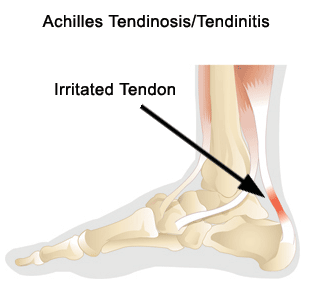 An overuse of the Achilles tendon is known as Achilles tendinitis. The Achilles tendon is the band of tissue which connects the calf muscles found at the back of the lower leg to the heel bone. Achilles tendinitis happens most times in runners who have suddenly increased the duration or intensity of their runs. It also happens with middle-aged people who play sports like basketball or tennis.
An overuse of the Achilles tendon is known as Achilles tendinitis. The Achilles tendon is the band of tissue which connects the calf muscles found at the back of the lower leg to the heel bone. Achilles tendinitis happens most times in runners who have suddenly increased the duration or intensity of their runs. It also happens with middle-aged people who play sports like basketball or tennis.
Many times, treatment can be done at home with simple methods. If this does not work, however, it is important you see your doctor. If the tendonitis worsens, it can lead to a tendon tearing. You could need a medication to ease the pain or even a surgical repair.
Symptoms of Achilles Tendinitis
Symptoms usually start out with a mild ache above the heel or in the back of the leg after running or another sports activity. Episodes of greater pain could happen after a long time of sprinting, running or stair climbing.
You could also experience stiffness or tenderness, in the morning especially, which will improve most times with some mild activity.
If you are experiencing pain around the Achilles tendon which is persistent, speak with your doctor. Seek medical attention right away if the disability or pain is severe. You could have a torn or ruptured Achilles tendon.
How to Treat Achilles Tendonitis
Achilles tendinitis treatments don’t necessarily include surgery. You should remember that it could take 2 to 3 months or more for the pain to subside.
1. Ice
You can try using ice on the Achilles tendon for fifteen to twenty minutes, two or three times each day. Take the ice off if numbness occurs.
2. Activity Change
You might be able to manage the symptoms more easily by changing activity:
- Stop or lower any activity which creates pain for you.
- Walk or run on softer and smoother surfaces.
- Switch to swimming, biking or other activities which put less strain on the Achilles tendon.
3. Footwear Change
They might also want you to make changes with your footwear:
- A boot, brace or cast to keep the tendon and heel still and let the swelling go down
- Placing heel lifts in the shoe under the heel
- Shoes which are softer in areas under and over the heel cushion
4. Compression
Compressive elastic bandages or raps could help lower swelling and movement of the tendon.
5. Elevation
Raise the foot which is affected above the level of your heart to lower swelling. Sleep with your foot elevated.
6. Exercises for Achilles Tendinitis
Your doctor or physical therapist can show you some stretching exercises for the Achilles tendon. You need to stretch and strengthen the muscles in your shins and calves to prevent the recurrence.
- One good way to do this is to sit on the floor with a weight strapped or taped to the front of one foot. Bend your knee at a ninety degree angle while your heel rests on the floor. Then lift the weight by pulling your toes towards you. Lower then repeat. You can do toe raises as well to strengthen your calves.
- Another good stretch for the Achilles is very easy as well. Stand on the balls of your feet on a curb, stairs or low rung of a ladder with your legs straight. Drop your heels down and hold them for a count of ten. Keep one foot flat and lower with the other heel to increase the intensity of the stretch, then switch legs.
7. Orthotic Devices
A wedge or shoe insert which elevates your heels lightly can relieve strain on the tendon and give a cushion that lowers the amount of force being exerted on your Achilles tendon.
8. Medications
NSAIDs, or nonsteroidal anti-inflammatory drugs like ibuprofen and aspirin may be helpful with the swelling and pain. Speak with your doctor about using them.
9. Sound Waves or Surgery
If these treatments don’t work, you could need surgery to take out the abnormal areas of the tendon and the inflamed tissue. Surgery could also be used to take out a bone spur that is irritating the tendon.
ESWT, or extracorporeal shock wave therapy could be an alternative to surgery for anyone who haven’t responded to other treatments. Low-does sound waves are used with this treatment.
Looking for more ways to help? Here're some excellent Achilles Tendonitis exercises:
Outlook or Prognosis
Symptoms of tendinitis can be improved with lifestyle changes. Symptoms can return, however, if you don’t limit the activities that are causing you pain, of if you don’t maintain the flexibility and strength of the tendon.
